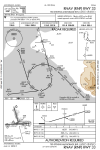Thanks for the humble pie, everyone. But, since we're on the topic, I have a legitimate question about this because I've heard different things from different people: does the T-45 have a GPS? I've been told it does not. I've been told "ehhh kinda." A sim instructor at CTW-6 was the only one to give me the most complete answer (which I think is correct): It has an INS where the jet's position information is regularly updated by a GPS receiver to minimize error in the INS. Without the GPS, the INS would nonetheless function just fine (with more error, of course).
I think some of the other points were very interesting, so I'm not trying to fly direct to DOUCH - I do apologize for coming off that way. I have heard and seen the FAA plans to decommission an increasing number of TACANs and replace them with RNAV waypoints (like the BFM TACAN just being a named RNAV waypoint like BRKLY or something), so it makes sense that Big Navy would want to increasingly rely on RNAV for enroute navigation and for instrument approaches. But tactically, is this the most sound decision to decommission the ground-based NAVAIDs? It would be easier for an adversary to degrade our nav satellites than disabling our ground-based VORTACs. I understand we're not getting rid of all of them, but I still think it's a bit shortsighted. I like RNAV navigation as much as anyone- it's far easier and more accurate, for instance, to proceed direct using GPS than doing a point-to-point, but I think (and it may be my ignorance, so grain of salt) it's tactically unsound to just decommission a bunch of TACANs and just rely increasingly on satellite-based navigation.

